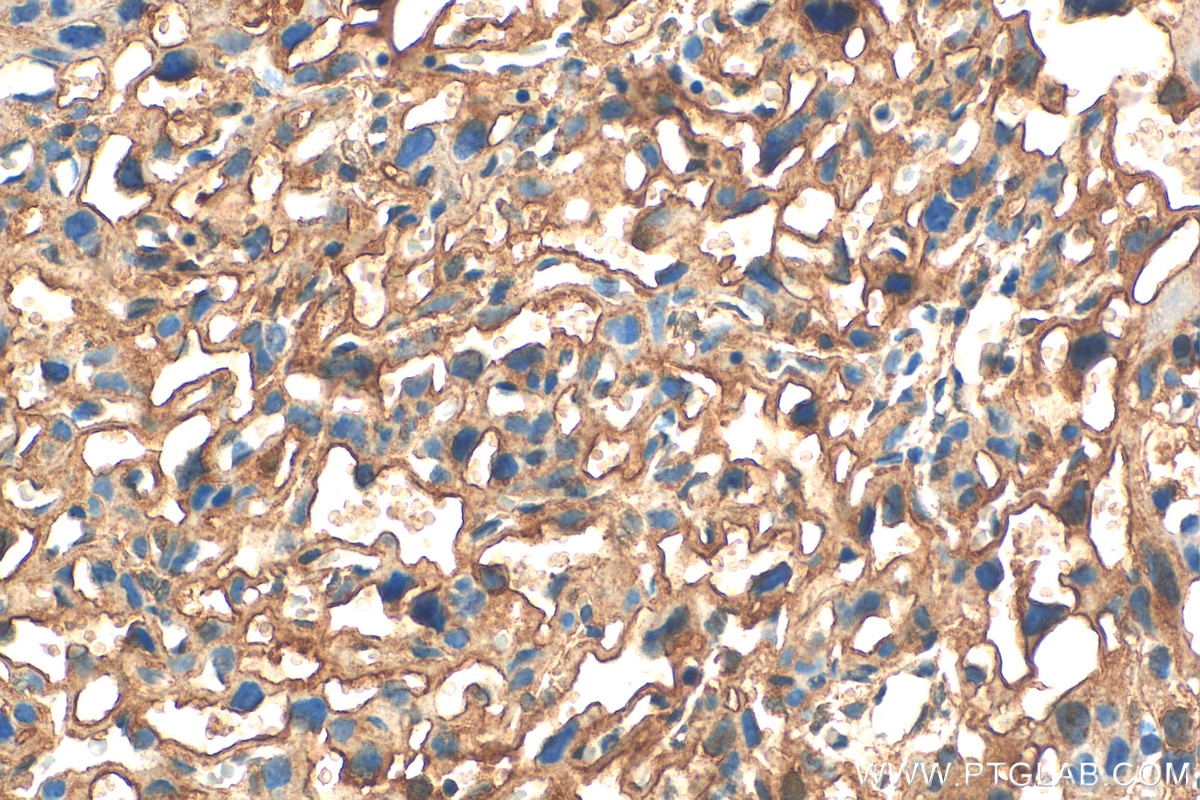Tested Applications
| Positive WB detected in | HUVEC cells, HeLa cells, HepG2 cells, mouse kidney tissue, rat kidney tissue |
| Positive IP detected in | mouse brain tissue |
| Positive IHC detected in | mouse placenta tissue, human tonsillitis tissue, human cervical cancer tissue Note: suggested antigen retrieval with TE buffer pH 9.0; (*) Alternatively, antigen retrieval may be performed with citrate buffer pH 6.0 |
Recommended dilution
| Application | Dilution |
|---|---|
| Western Blot (WB) | WB : 1:1000-1:8000 |
| Immunoprecipitation (IP) | IP : 0.5-4.0 ug for 1.0-3.0 mg of total protein lysate |
| Immunohistochemistry (IHC) | IHC : 1:50-1:500 |
| It is recommended that this reagent should be titrated in each testing system to obtain optimal results. | |
| Sample-dependent, Check data in validation data gallery. | |
Published Applications
| KD/KO | See 3 publications below |
| WB | See 52 publications below |
| IHC | See 7 publications below |
| IF | See 10 publications below |
Product Information
13578-1-AP targets ABCG1 in WB, IHC, IF, IP, ELISA applications and shows reactivity with human, mouse, rat samples.
| Tested Reactivity | human, mouse, rat |
| Cited Reactivity | human, mouse, rat |
| Host / Isotype | Rabbit / IgG |
| Class | Polyclonal |
| Type | Antibody |
| Immunogen |
CatNo: Ag4479 Product name: Recombinant human ABCG1 protein Source: e coli.-derived, PGEX-4T Tag: GST Domain: 1-353 aa of BC029158 Sequence: MACLMAAFSVGTAMNASSYSAEMTEPKSVCVSVDEVVSSNMEATETDLLNGHLKKVDNNLTEAQRFSSLPRRAAVNIEFRDLSYSVPEGPWWRKKGYKTLLKGISGKFNSGELVAIMGPSGAGKSTLMNILAGYRETGMKGAVLINGLPRDLRCFRKVSCYIMQDDMLLPHLTVQEAMMVSAHLKLQEKDEGRREMVKEILTALGLLSCANTRTGSLSGGQRKRLAIALELVNNPPVMFFDEPTSGLDSASCFQVVSLMKGLAQGGRSIICTIHQPSAKLFELFDQLYVLSQGQCVYRGKVCNLVPYLRDLGLNCPTYHNPADFVMEVASGEYGDQNSRLVRAVREGMCDSDH Predict reactive species |
| Full Name | ATP-binding cassette, sub-family G (WHITE), member 1 |
| Calculated Molecular Weight | 678 aa, 76 kDa |
| Observed Molecular Weight | 75 kDa |
| GenBank Accession Number | BC029158 |
| Gene Symbol | ABCG1 |
| Gene ID (NCBI) | 9619 |
| RRID | AB_2220174 |
| Conjugate | Unconjugated |
| Form | Liquid |
| Purification Method | Antigen affinity purification |
| UNIPROT ID | P45844 |
| Storage Buffer | PBS with 0.02% sodium azide and 50% glycerol, pH 7.3. |
| Storage Conditions | Store at -20°C. Stable for one year after shipment. Aliquoting is unnecessary for -20oC storage. 20ul sizes contain 0.1% BSA. |
Background Information
ABCG1 is a cholesterol and phospholipid transporter expressed in lung, brain, spleen, and macrophages. In liver, ABCG1 is expressed mainly in Kupffer cells. The monomer of ABCG1 is around 60-65 kDa, while multiple forms of ABCG1 can be observed on SDS-PAGE, including 130 kDa (dimer), 90-95 kDa, 110 kDa. It was not clear whether the glycosylation or splicing accounts for the differences in mass. (PMID: 16702602)
Protocols
| Product Specific Protocols | |
|---|---|
| IHC protocol for ABCG1 antibody 13578-1-AP | Download protocol |
| IP protocol for ABCG1 antibody 13578-1-AP | Download protocol |
| WB protocol for ABCG1 antibody 13578-1-AP | Download protocol |
| Standard Protocols | |
|---|---|
| Click here to view our Standard Protocols |
Publications
| Species | Application | Title |
|---|---|---|
Cancer Res PRMT1 sustains de novo fatty acid synthesis by methylating PHGDH to drive chemoresistance in triple-negative breast cancer | ||
Autophagy Metabolic effects of RUBCN/Rubicon deficiency in kidney proximal tubular epithelial cells. | ||
Br J Pharmacol Functional interplay between LXR and AMPKα inhibits atherosclerosis in apoE deficient mice - A new anti-atherogenic strategy. | ||
J Pharm Anal Targeted delivery of rosuvastatin enhances treatment of hyperhomocysteinemia-induced atherosclerosis using macrophage membrane-coated nanoparticles | ||
Phytomedicine Rice bran active peptide (RBAP) inhibited macrophage differentiation to foam cell and atherosclerosis in mice via regulating cholesterol efflux | ||
Phytomedicine MaiJiTong granule attenuates atherosclerosis by reducing ferroptosis via activating STAT6-mediated inhibition of DMT1 and SOCS1/p53 pathways in LDLR-/- mice |
Reviews
The reviews below have been submitted by verified Proteintech customers who received an incentive for providing their feedback.
FH Shiford (Verified Customer) (09-24-2023) | We sorted cancer stem cell subpopulations from multiple cell lines by flow cytometry and used a cluster of antibodies related to stem cell characteristics to detect. ABCG1 is one of the possible stem cell markers, with clear bands.
 |
















